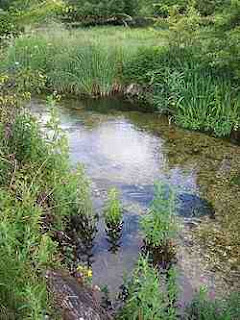 |
Zephyrus, the Greek God of the west wind and the goddess Chloris, from an 1875 engraving by William-Adolphe Bouguereau |
The Zephyr wind prevailed yesterday keeping Boreas, the Greek god of the cold or wet north wind, at bay for the very British Royal Wedding of Prince William and Catherine.
Zephyrus is the Greek god of the west wind, which is the gentlest of winds and for the last month it has woven its way through the ABC stories in Positive Letters and here tells the final tale.
The Zephyr rustled the seeds of the Ash tree, floated in and around the Barn, tickled the Canal waters creating a gentle ripple; the Downs came next ... the beautiful chalk meadow flowers, including the Eyebright swayed as the gentlest of winds passed through.
Then the grip of the Forest, where the Graphite needed blowing clean, out into the fields to see the boxing Hares, ruffling the Insects wherever the Zephyr passes; another trip to the seaside to encourage the seas to keep the Jellyfish off shore.
A long Zephyr glide with the Kites as the lift takes them to the Lakes – a magnificent view ... the gentle breeze spots a moated Manor ... and dreams of history past, remembering the Naturalists it helped by tickling the flora and fauna .. so those meticulous recorders left something for the scientists of today to ponder over ...
... perhaps then as now many will sit under the teeming Oak, thinking about the world within its branches or mingled in its roots ... those Pigs of yore certainly were grateful to the generous oak ... did the ancients use their Quern stones to grind acorns for flour ... we may wonder.
 |
The Palace of the Four Winds – a baroque palace in Warsaw, built about 1680. |
But Ratty, the Vole, is delighted to find his whiskers tickled by the Zephyr ... another lovely day for messing about in boats ... perhaps with a picnic ... after Toad, Badger and Mole have joined him in his bijou residence to watch the World and the Windsors celebrate that very British 21st century Wedding in Westminster Abbey.
The Zephyr is now sad that the Xerces Blue was not with us to enjoy the wonderful day, but the Yoke of burden must lift as the story of the Zephyr is remembered here at Happy Hilary’s positive home. Success is attained in bringing the ABCs to their timely conclusion with the Zephyr – that messenger of things to come.
Ze end!
This is Zephyr – that is what Z is for ...
Part of the ABC - April 2011 - A - Z Challenge - Aspects of the British Countryside
Hilary Melton-Butcher
Positive Letters Inspirational Stories



















